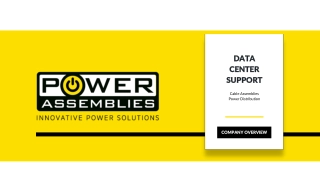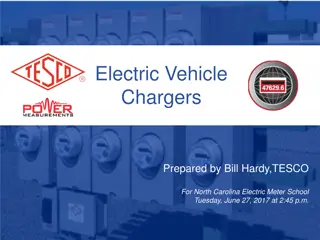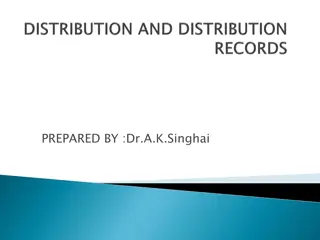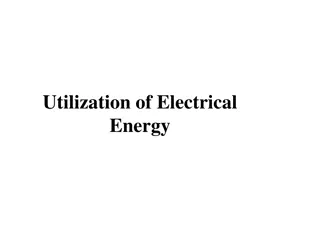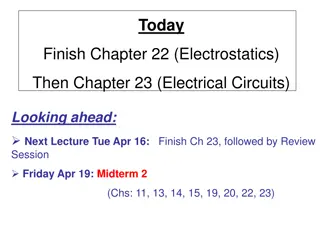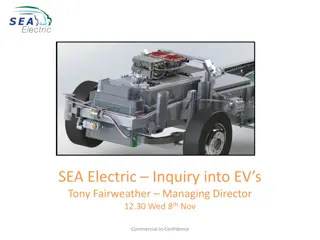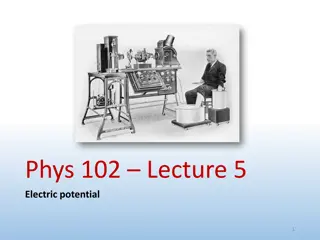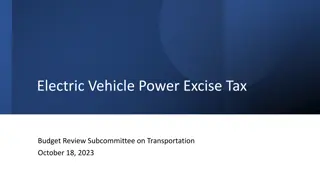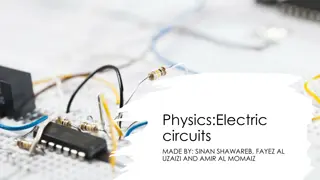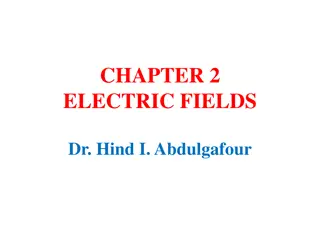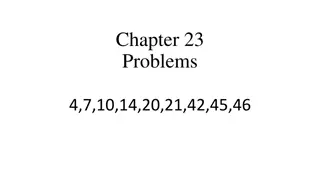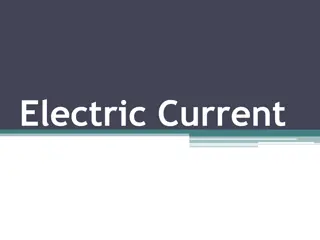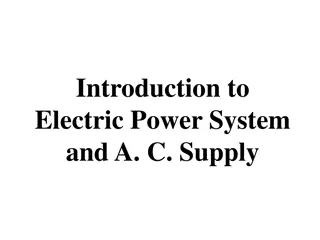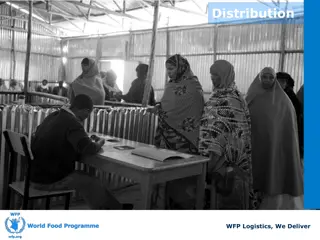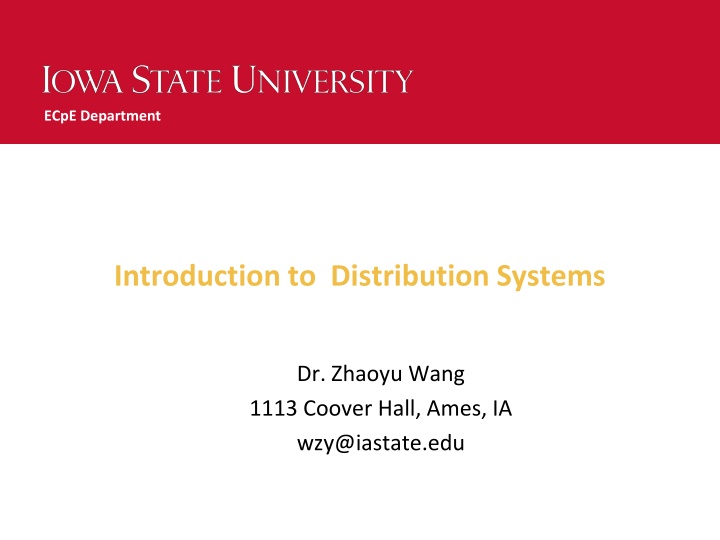
Overview of Electric Power Distribution Systems
Electric power systems consist of generation, transmission, and distribution components. Distribution systems play a crucial role in delivering power to consumers efficiently. This includes substations, transformers, feeders, and various devices that ensure reliable power supply to residential, commercial, and industrial loads. Understanding the structure and function of distribution systems is essential for efficient energy management and grid operation.
Download Presentation

Please find below an Image/Link to download the presentation.
The content on the website is provided AS IS for your information and personal use only. It may not be sold, licensed, or shared on other websites without obtaining consent from the author. If you encounter any issues during the download, it is possible that the publisher has removed the file from their server.
You are allowed to download the files provided on this website for personal or commercial use, subject to the condition that they are used lawfully. All files are the property of their respective owners.
The content on the website is provided AS IS for your information and personal use only. It may not be sold, licensed, or shared on other websites without obtaining consent from the author.
E N D
Presentation Transcript
ECpE Department Introduction to Distribution Systems Dr. Zhaoyu Wang 1113 Coover Hall, Ames, IA wzy@iastate.edu
Introduction to Energy Distribution Systems Acknowledgement: The slides are developed based in part on Electric Power and Energy Distribution Systems, Models, Methods and Applications, Subrahmanyan S. Venkata, Anil Pahwa, IEEE Press & Wiley, 2022 2 ECpE Department
The Electric Power System Electric power systems have three main building blocks: generation, transmission, and distribution. In terms of capital expenditure, Generation systems make up approximately 40% ; Transmission systems make up 20%; and Distribution systems make up 40%. Distribution systems are the subsystem closest to consumers. A distribution system starts with a distribution substation that steps down power from a transmission level to a primary distribution level between 4.16 and 34.5 kV. A distribution substation has a power handling capability of 5 to 25 MVA and may feed 2 to 8 three-phase primary feeders. Laterals branch off from primary feeders and power is further stepped down to a secondary distribution level of 600 V or less via distribution transformers. 3 ECpE Department
The Electric Power System Secondary lines feed residential loads, while commercial and industrial loads may be fed directly from the primary level or via secondary distribution. Most distribution systems are overhead due considerations, but underground systems are becoming popular due to aesthetics and higher reliability. to cost 4 ECpE Department
Comparison of Distribution and Transmission Systems 5 ECpE Department
Layout of a Typical Distribution System 6 ECpE Department
Distribution System Devices Distribution systems have a variety of devices from the substation to customer service entrances, including: 1. Substation Devices Control and monitoring Compensating devices Protection equipment Transformers Switchgear 2. Primary System Components Feeders and Laterals Compensating Devices Protection Equipment Distribution Transformers Switches 3. Secondary System Components 7 ECpE Department
1. Substation Devices Distribution substations are the link between the transmission system and the distribution system. Distribution substations can be located on the periphery or inside cities, and may be part of a large transmission substation. Modern distribution substations are typically gas-insulated, with sulfur hexafluoride (SF6) being the most common gas used. However, there are some environmental concerns associated with SF6, leading researchers to look for alternatives. 8 ECpE Department
1. Substation Devices The right side of figure shows the 115 kV side with incoming feeder, switching equipment, and busbars, while the left side shows the 12.47 kV side with a power transformer in the middle. 9 ECpE Department
1.1 Power Transformers Power transformers receive power from the transmission system and reduce the voltage for distribution to consumers. These transformers have multiple power ratings, such as 15/20/25 MVA OA/FA/FOA, which indicate the transformer will handle: up to 15 MVA with cooling provided by convective flow of oil through fins (OA), up to 20 MVA with additional cooling provided by fans circulating air through fins (FA), and up to 25 MVA with cooling aided by forced air as well as forced oil circulation (FOA). Power transformers typically have a load tap changer (LTC) on the secondary side to adjust the low-voltage side voltage based on system load. 10 ECpE Department
1.2 Switchgear Switchgear refers to devices used to open or close electrical paths in a distribution system. The most important part of these devices is the circuit breaker, which opens the electrical path under fault conditions. o Circuit breakers can use air, oil, vacuum, or gas as the media for interruption. o High-voltage circuit breakers are typically SF6 -based, while circuit breakers in the 15 kV class often use vacuum-based interruption mechanisms. Load break switches are used to interrupt a circuit, but their capacity is limited to the maximum expected load on the circuit and cannot interrupt a circuit under fault conditions. Disconnect switches are manual devices used to isolate a circuit or component that has already been de-energized. 11 ECpE Department
1.3 Compensating Device Compensating devices are used in a distribution system to adjust the voltage or reactive power flow. These devices include: Regulators: These devices are autotransformers that can change the output voltage by moving the tap up or down. Capacitors: These devices provide reactive power and can be fixed or switched. Switch capacitors can be turned on to provide reactive power in response to voltage, reactive power flow, or temperature, or they can have a fixed time-based switching schedule. Reactors: These devices can be installed in substations to absorb reactive power. They are not commonly used in distribution substations, but may be used in transmission substations to compensate for the reactive power of high-voltage transmission lines under light load conditions. 12 ECpE Department
1.4 Protection Equipment Protection equipment in a distribution system is designed to respond to abnormal conditions such as high current due to faults and high voltage caused by circuit switching or lightning. These types of equipment include: Relays: Inverse time overcurrent and instantaneous relays are the most common types of relays used in distribution systems. They monitor the current on distribution feeders emanating from the substation and send trip signals to associated circuit breakers to trip if the current exceeds a certain threshold. Fuses: High-voltage fuses are sometimes used on the high-voltage side of power transformers to protect them from faults. Surge arresters: These devices limit voltage on equipment by discharging or bypassing surge current created by switching or lightning. Static wires: These wires, which are located at the top of poles bringing an overhead transmission line into the substation or an overhead distribution line going out of the substation, protect substation equipment during lightning storms by diverting lightning surges to the ground. 13 ECpE Department
1.5 Control and Monitoring Devices Current transformers (CTs) reduce the current flowing on lines to lower values for meters and relays. Voltage transformers (VTs) or potential transformers (PTs) reduce high voltage to a lower value for metering and protection. Capacitive voltage transformers (CVTs) use the capacitive principle to reduce voltage. Substations have transducers to measure quantities such as ambient temperature, oil temperatures of transformers, and dissolved gases in transformer oil. Modern substations use cyber technology, including computers and communication links (e.g. microwave, fiber optics, radio) and remote terminal units (RTUs) to collect and convey information to the supervisory control and data acquisition (SCADA) system in the control room. 14 ECpE Department
2. Primary System Components The consists of feeders that extend from the substation transformers. primary distribution system to distribution Figure on the right shows an example of an overhead primary distribution feeder along a city street. These feeders can have different configurations and conductor types and have associated devices for protection and control. This section provides a brief overview of these devices. 15 ECpE Department
2.1 Feeders and Laterals Feeders and laterals in a distribution system can be overhead or underground. Overhead feeders have bare conductors mounted on poles and can use copper, aluminum, or aluminum conductor steel reinforced (ACSR) conductors. o ACSR conductors are the most commonly used bare wires for overhead distribution feeders. Underground feeders use insulated cables with copper or aluminum conductors and are insulated with ethylene propylene rubber (EPR) or cross-linked polyethylene (XLPE) polymeric insulation. Tree wires are another option for overhead feeders and are made of copper or aluminum conductors coated with insulation. They are used in areas with dense vegetation and high likelihood of contact with trees. 16 ECpE Department
2.2 Switches Primary feeders in a distribution system are typically three-phase and have different types of switches installed for operating flexibility. Manual switches are used to isolate a part of the feeder for maintenance and can only operate on a de-energized feeder. Sectionalizing switches or sectionalizers isolate parts of a feeder under fault conditions and do not have fault-clearing capabilities, but operate in conjunction with reclosers, which do have fault-clearing capabilities. Sectionalizers have a counting mechanism to count the number of times the recloser has operated, and after a predetermined number of operations, they open when the recloser is open to disconnect the downstream part of the feeder. Advanced sectionalizing switches with communication capabilities are being deployed in automated systems to precisely locate faults and isolate the faulted part from the rest of the system. 17 ECpE Department
2.2 Switches Three-phase main feeders also have a switch at the end, called a tie switch, which is normally open and can be manual or automated. o In modern systems, tie switches are often automated to provide higher flexibility for system reconfiguration. 18 ECpE Department
2.3 Compensating Devices Capacitors: Installed to inject reactive power and maintain proper voltage on feeders under changing load conditions. o Capacitors can be switched based on local control using time, temperature, voltage, reactive power, or a combination of them. o Capacitors can also be switched in coordination with other devices in the system. Voltage regulators: They are like autotransformers and is used on long feeders to boost voltage under heavy load conditions. 19 ECpE Department
2.4 Protection Equipment Fuses: Most common protection equipment, used on lateral branches and main feeders, inexpensive but must be manually replaced. o Every lateral branching off the main feeders has a fuse to protect it. o The main feeder can have fuses in certain situations. o They are also used to protect distribution transformers. Fuses are very inexpensive and have provided reliable protection for over a century. A disadvantage with them is that they must be manually replaced. One can argue that they should be replaced by automated protective devices, however, the cost advantage they offer outweighs any benefits an automated protective device would provide. Hence, they will continue to be used for protection of downstream portions of distribution systems. 20 ECpE Department
2.4 Protection Equipment Reclosers: like circuit breakers and have fault-clearing capabilities, unlike circuit breakers, which depend on separate relays to initiate operation during faults, reclosers have their own fault detection mechanism, are smaller in size and are mounted on top of poles in overhead feeders and are mounted on poles. have reclosing feature which allows them to reclose a selected number of times before locking out. Since many faults in distribution systems are temporary, this feature permits fuse saving for such faults. Surge arresters: Protects against lightning and switching surges. Static lines: Protects against voltage transients. 21 ECpE Department
2.5 Control and Monitoring Devices Emerging distribution systems with automation have more control and monitoring devices, including CTs, VTs, transducers, and RTUs. Automated distribution systems have an overly communication network for communication between devices and the control center. These devices provide real-time data for optimal operating decisions at the control center. 22 ECpE Department
2.6 Distribution Transformers Located at the end of the primary distribution system. Reduce voltage to utilization level for distribution to customers. Pole-mounted for overhead systems, pad-mounted for underground systems. Single phase for residential customers, three phase for commercial and industrial customers, depending on the size of the load. Single-phase transformer typically feeds 1-8 residential customers through the secondary part of the system. 23 ECpE Department
Types of Primary Systems Primary distribution systems can be public or private. Large consumers, such as process industries and universities, often have their own primary distribution systems connected to the local utility. Ships use three-phase distribution at 60 Hz, while aircraft and space systems use 400 Hz 24 ECpE Department
3. Secondary System Components Connects distribution transformers to service entrance in homes and businesses. Overhead systems use triplex cable, underground systems use aluminum cable. Service entrance has a meter to record energy consumption, smart meters allow remote metering and report loss of power to utilities. Customers can install their own generation and storage devices, including rooftop solar PV and batteries for residential customers, and co- generation systems (solar, wind, batteries, fuel cells) for industrial and commercial customers. 25 ECpE Department
Thank You! 26 ECpE Department



